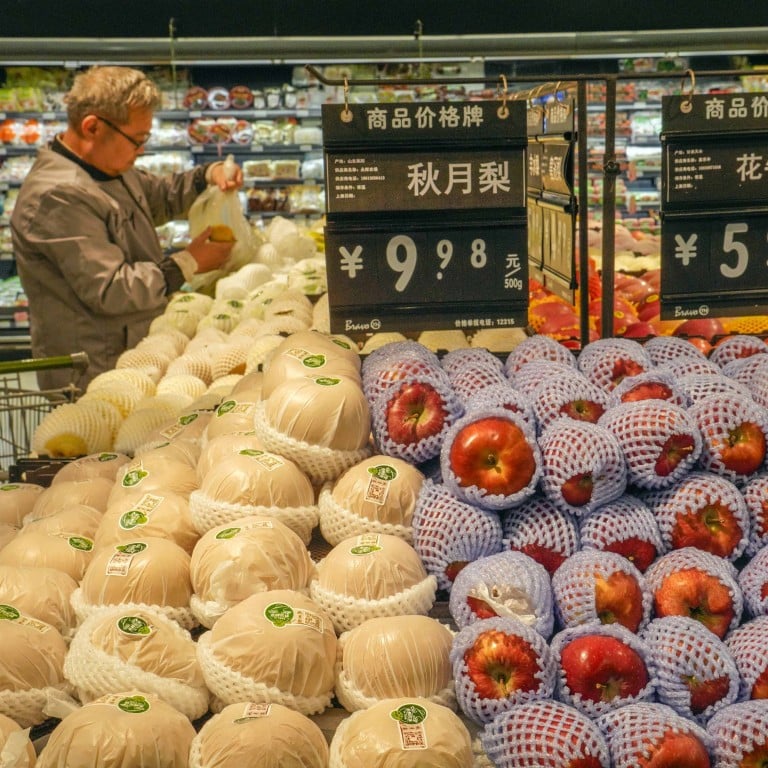
Explainer | China inflation: 4 takeaways from October’s data as pork pummels consumer prices, but is it deflation?
- China’s consumer price index (CPI) fell by 0.2 per cent from a year earlier in October due to deepening food-price deflation
- Producer price index (PPI) fell for the 13th month in a row, dropping by 2.6 per cent in October from a year earlier
1. China is not experiencing ‘deflation’
The main culprit for the decline was a deepening of food-price deflation, according to analysts at Capital Economics, with pork prices subsiding as supplies increased.
Within CPI, overall food prices dropped by 4 per cent last month, year on year, while non-food prices rose by 0.7 per cent.
Within food prices, the negative pork-price-inflation reading deepened in October to minus 30.1 per cent, year on year, due to both a high base and sequentially lower pork prices, said Robert Carnell, regional head of research for Asia-Pacific at ING.
He said month-on-month pork-price inflation dropped to minus 2 per cent in October from 0.2 per cent in September.
China’s weak consumer prices continue in October, deflationary pressure deepens
“China is not experiencing ‘deflation’ as most headlines attest. But its pork prices are undoubtedly much lower – good news for all except farmers, probably,” Carnell said. “What China has right now is a low rate of underlying inflation, which reflects the fact that domestic demand is fairly weak.
“What the [October] data showed is that it doesn’t take much of a negative shock from one of the components to push a low underlying headline inflation rate below zero on a year-on-year basis.”
2. Factory-gate prices deepen for the first time in 4 months
China’s producer price index (PPI) – which reflects the prices that factories charge wholesalers for products – fell by 2.6 per cent in October from a year earlier, compared with a fall of 2.5 per cent in September, deepening for the first time in four months.
“The dip in PPI inflation in October was driven by both the sequential fall across domestic and global energy prices, and a higher base from last year,” said analysts from Nomura.
According to analysts at Capital Economics, PPI deflation deepening for the first time in four months reflects a stronger base for comparison from a year ago, as factory-gate prices were unchanged from September, month on month.
“Increases in the price of energy and chemical products offset declines in metal prices,” they said.
3. Core inflation decline adds to ‘wider signs’ of economic slowdown
China’s core inflation, which receives more attention from policymakers as it excludes volatile food and energy prices, rose by 0.6 per cent last month, year on year, following 0.8 per cent growth in September – marking the first decline in four months.
“This adds to wider signs, including from the latest PMIs, of a renewed loss of economic momentum recently,” said analysts at Capital Economics.
4. ‘As demand builds, prices should follow suit’
With the base effects weighing on food, and producer-price inflation set to ease, analysts at Capital Economics expect headline CPI to rise over the coming months and average around 1 per cent in 2024, while factory-gate deflation should also ease next year.
“Chinese inflation looks set to remain low for the foreseeable future,” they said. “But we don’t think the country is about to enter a deflationary spiral.”
They expect core inflation to return above 1 per cent in the first half of 2024 as policy support “holds a hand under domestic demand and supports a further increase in services inflation”.
“It may also nudge up core goods inflation,” they added.
As demand builds, prices should follow suit
Jeemin Bang, an associate economist at Moody’s Analytics, said that despite some signs of domestic demand gaining steam in China, the price data does not tell the same story.
“Under the hood, the situation isn’t as disastrous as one might expect,” she said.
She foresees CPI reaching 0.7 per cent by December and building to 2.5 per cent by the end of 2024.
“The Chinese economy has shown signs of finding its footing – notably with a surprisingly strong third-quarter [gross domestic product] print. As demand builds, prices should follow suit,” she said.

.JPG?itok=J8tgfPmW&v=1659948715)